An asteroid on a collision course with Earth could potentially be deflected without the need for a spacecraft to physically impact it. Researchers have discovered that X-rays could be the key to diverting these space rocks, as reported in Nature Physics on September 23. In laboratory experiments, scientists used X-ray radiation to heat the surfaces of simulated asteroids, creating vapor plumes that pushed the objects away. Further computer simulations showed that X-rays emitted from a distant nuclear explosion could deflect asteroids roughly the size of the National Mall in Washington, D.C.
“There’s only one method that has been proposed that has enough energy to deflect the most threatening asteroids, the largest asteroids, or in some cases even smaller asteroids where warning time is short,” says physicist Nathan Moore of Sandia National Laboratories in Albuquerque. “The consensus in the planetary defense community is that X-rays from a nuclear device would be the only option in those scenarios.” Such blasts would theoretically occur at safe distances from Earth.
Two years ago, NASA intentionally crashed a spacecraft into asteroid Dimorphos, altering its orbit around a larger asteroid. This was a significant moment for planetary defense, but such impacts are only effective if the asteroid is small and there is enough time to alter its trajectory, according to Moore. Therefore, he and his colleagues set out to test the effectiveness of X-rays in deflecting asteroids.
The experiment began in a vacuum chamber containing a blueberry-sized mock asteroid made of quartz. Using the world’s most powerful X-ray generator, the team subjected the chamber to a 6.6-nanosecond blast. This pulse vaporized the foil supports holding the quartz, causing it to free fall. The X-rays also heated and vaporized the falling mineral’s surface, generating a gas plume. The expanding plume acted like a rocket’s exhaust, propelling the quartz away from the X-ray source at approximately 250 kilometers per hour. Similar results were obtained with fused silica.
To assess the scheme’s viability for planetary defense, the experimental results were incorporated into computer simulations. The simulations indicated that X-rays from a nuclear blast a few kilometers away could deflect an asteroid of similar composition up to 4 kilometers wide. The researchers plan to conduct further experiments with iron and other asteroid constituents, as asteroids are composed of various minerals. “This is just a starting point,” Moore concludes.






